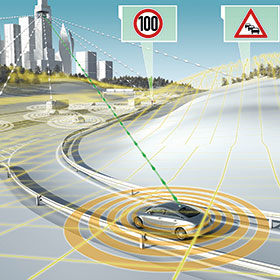

According to Gartner’s IT Glossary the word telematics is a merger of tele and matics – short for ‘telecommunications’ and ‘information’, and one of its core functions is to record information about vehicles and send, receive, process and store this data via telecommunications devices. This technology also allows for control of vehicles on the move.
Today and in the future, telematics technology integrates with connected cars and smart home technologies, where users can control features within their homes from their vehicles’ dashboard. Examples include US-based AT&T’s Digital Life, a home security and automation service, as well as Drive, a connected car service. Users can control devices in the home from their car, like turn the lights on, turn the thermostat up and switch on the coffee maker – demonstrating the significant role telematics and Internet-connected devices can play in the modern lifestyle.
Telematics within the consumer and fleet management space
GPS tracking, monitoring how you drive, emergency warning systems and stolen vehicle recovery are all covered by the telematics umbrella. Practical applications where telematics can help improve the efficiency of a fleet include monitoring the location, movements, status and behaviour of the vehicle via an onboard computer, and monitoring the driver through in-cab video systems.
The basic telematics system is enabled by a hardware device that is installed in the vehicle, or any asset for that matter. A SIM card and modem in the device enables communication on the cellular network. The data derived from the telematics device like the vehicle’s GPS position, the G-forces measured by the built-in accelerometer, and the speed that the vehicle is moving at, is sent in an encrypted packaged format to the data centre. Here, this message gets decoded in order for the data centre to obtain the condition and whereabouts of the vehicle. The data is turned into information by management reporting tools in conjunction with a visual display on computerised mapping software. This ultimately forms the cornerstone of vehicle tracking and stolen vehicle recovery. This information can also be accessed by the consumer directly, through the use of a mobile application or Internet tracking software, enabling the consumer to monitor their vehicle in real time and alerting them – through early warning and crash alerts – should there be any movement on their car or when their car has been in an accident.
For fleet management the telematics data being derived from the onboard computer includes operating hours, location, fuel consumed, and odometer reading. Fleet management software includes functionality for monitoring and managing driver and asset performance, controlling communication costs, reporting on fleet operating costs, active (real-time) and passive (after-the-fact) tracking of assets and drivers, location management, communication and messaging, route planning and variance reporting, trailer management, asset maintenance reporting, service reminders and much more.
Peripheral solutions
Telematics solutions include various peripherals for example an in-cab display through which drivers are able to obtain their route information, as well as driving-related events such as speeding, over revving, harsh braking, harsh acceleration and excessive idling. An advanced fleet management solution has numerous benefits including reducing fuel costs, better managing routes and delivery schedules, improving vehicle utilisation, tracking vehicles and drivers in real-time and assigning jobs accordingly, monitoring and managing poor driver behaviour and managing servicing and licensing.
With data being the new currency for businesses, telematics and the real-time usage of data is quickly moving from being optional to a requirement, and will soon become an invaluable part of a business’ operations in order to gain a competitive edge and remain one step ahead in tough economic times. While telematics was originally exclusively used by large enterprises, today nearly any type of business can utilise it and use the opportunities presented by the IoT to elevate the business, reduce costs and simplify operations.
For more information contact MiX Telematics, +27 (0)11 654 8000, www.mixtelematics.co.za
© Technews Publishing (Pty) Ltd | All Rights Reserved